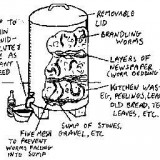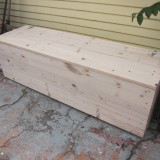
Garden Professor Jeff Gillman analyzed worm leachate (the liquids the flow our of your worm bin) from a home vemicompost setup. It’s pretty strong stuff! Gillman concludes,
this could be a great liquid fertilizer if it were used properly. I’d recommend diluting it somewhere between 1:1 and 1:5 worm juice : water before applying it, and I’d only apply it once every week or two. If you want to use it, try it on something that you’re not too concerned about first, just to make sure that it doesn’t do anything too terrible (It shouldn’t, but I believe in caution).
To see a full analysis, read his post here.





I have several big worm bins, a worm tower, and a small black portable worm bin next to my back door. The only way I can collect leachate is from the tower with the way my bins are set up. I usually just collect and dump right back over the bin contents. There are usually a ton of worm castings and babies, among other wonderful things.
I’ve just moved to a new property whose soil has been badly neglected since, oh, probably the time the house was built. Now I take all the leachate and just pour it at will into the garden beds or anywhere there is exposed soil (that looks parched and devoid of life). Hose off with some water and watch the microbes work!
I always just add the liquid to the water I use to water the plants, it’s great stuff1 I have a home-made worm bin that stands in a container so that the liquid collects there, and about once a week I then use it as liquid fertilizer. So far the plants have loved it, but I agree, I would never use it un-diluted, that would be too strong.
I combined your posts and just added worm leachate to my hay bail garden…time will tell.
If you put the leachate back in at the top do be careful that the vermiculture doesn’t get saturated, as the compost needs to be well drained and all the while be letting air into the whole of the compost mass.